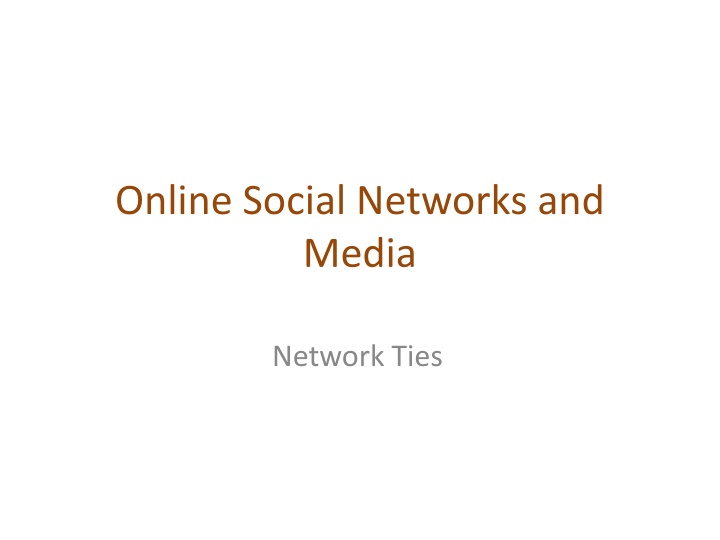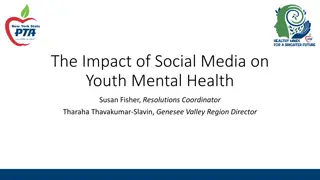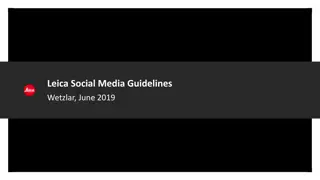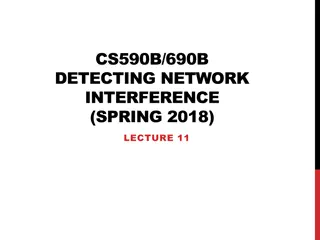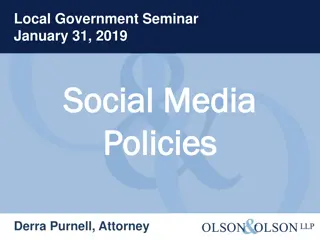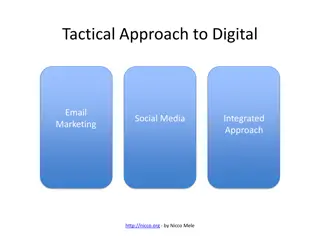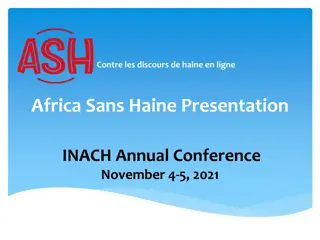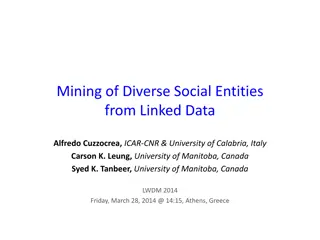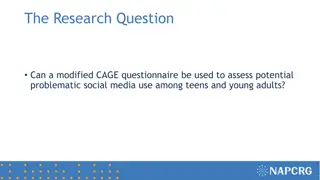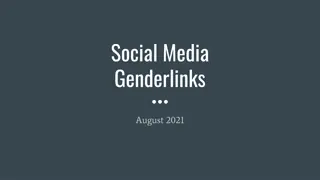Online Social Networks and Media: Impact on Population Dynamics
Simple processes at individual node level can result in complex effects at a population scale within online social networks. Explore the formation of ties, information flow, assortativity, influence, homophily, and triadic closure in network structures.
Download Presentation

Please find below an Image/Link to download the presentation.
The content on the website is provided AS IS for your information and personal use only. It may not be sold, licensed, or shared on other websites without obtaining consent from the author.If you encounter any issues during the download, it is possible that the publisher has removed the file from their server.
You are allowed to download the files provided on this website for personal or commercial use, subject to the condition that they are used lawfully. All files are the property of their respective owners.
The content on the website is provided AS IS for your information and personal use only. It may not be sold, licensed, or shared on other websites without obtaining consent from the author.
E N D
Presentation Transcript
Online Social Networks and Media Network Ties
Introduction How simple processes at the level of individual nodes and links can have complex effects at the whole population How information flows within the network How links/ties are formed and the distinct roles that structurally different nodes play in link formation
Assortativity similar nodes are connected with each other more often than with dissimilar nodes
Why are friendship networks assortative (similar)? (Social) Influence (or, socialization): an individual (the influential) affects another individual such that the influenced individual becomes more similar to the influential figure Selection (Homophily): similar individuals become friends due to their high similarity Confounding: the environment s effect on making individuals similar/Surrounding context: factors other than node and edges that affect how the network structure evolves (for instance, individuals who live in Russia speak Russian fluently) Mutable & immutable characteristics
Influence vs Homophily Individuals already linked together change the values of their attributes Connections are formed due to similarity
Influence vs Homophily Which social force (influence or homophily) resulted in an assortative network?
Triadic Closure If two people in a social network have a friend in common, then there is an increased likelihood that they will become friends themselves at some point in the future Triangle
Triadic Closure Snapshots over time:
Clustering Coefficient (Local) clustering coefficient for a node is the probability that two randomly selected friends of a node are friends with each other (form a triangle) { | 2 k | } jk e , , , size of N , i N neigborhoo i d of u e E u u Ni k = jk i j i C i ) 1 ( k i i Fraction of the friends of a node that are friends with each other (i.e., connected) i triangles centered at node i (1) = C i triples centered at node i
Clustering Coefficient 1/6 1/2 Ranges from 0 to 1
Triadic Closure If A knows B and C, B and C are likely to become friends, but WHY? B A C 1. Opportunity 2. Trust 3. Incentive of A (latent stress for A, if B and C are not friends, dating back to social psychology, e.g., relating low clustering coefficient to suicides)
The Strength of Weak Ties Hypothesis Mark Granovetter, in the late 1960s Many people learned information leading to their current job through personal described as acquaintances rather than closed friends contacts, often Two aspects Structural Local (interpersonal)
Bridges and Local Bridges Bridge (aka cut-edge) An edge between A and B is a bridge if deleting that edge would cause A and B to lie in two different components AB the only route between A and B extremely rare in social networks
Bridges and Local Bridges Local Bridge An edge between A and B is a local bridge if deleting that edge would increase the distance between A and B to a value strictly more than 2 Span of a local bridge: distance of the its endpoints if the edge is deleted
Bridges and Local Bridges An edge is a local bridge, if an only if, it is not part of any triangle in the graph
The Strong Triadic Closure Property Levels of strength of a link Strong and weak ties May vary across different times and situations Annotated graph
The Strong Triadic Closure Property If a node A has edges to nodes B and C, then the B-C edge is especially likely to form if both A-B and A-C are strong ties A node A violates the Strong Triadic Closure Property, if it has strong ties to two other nodes B and C, and there is no edge (strong or weak tie) between B and C. A node A satisfies the Strong Triadic Property if it does not violate it B S A X S C
Local Bridges and Weak Ties Local distinction: weak and strong ties -> Global structural distinction: local bridges or not Claim: If a node A in a network satisfies the Strong Triadic Closure and is involved in at least two strong ties, then any local bridge it is involved in must be a weak tie Proof: by contradiction Relation to job seeking?
The role of simplifying assumptions: Useful when they lead to statements robust in practice, making sense as qualitative conclusions that hold in approximate forms even when the assumptions are relaxed Stated precisely, so possible to test them in real-world data A framework to explain surprising facts
Tie Strength and Network Structure in Large-Scale Data How to test these prediction on large social networks?
Tie Strength and Network Structure in Large-Scale Data Communication network: who-talks-to-whom Strength of the tie: time spent talking during an observation period Cell-phone study [Omnela et. al., 2007] who-talks-to-whom network , covering 20% of the national population Nodes: cell phone users Edge: if they make phone calls to each other in both directions over 18-week observation periods Is it a social network ? Cells generally used for personal communication + no central directory, thus cell- phone numbers exchanged among people who already know each other Broad structural features of large social networks (giant component, 84% of nodes)
Generalizing Weak Ties and Local Bridges So far: Either weak or strong Local bridge or not Tie Strength: Numerical quantity (= number of min spent on the phone) Quantify local bridges , how?
Generalizing Weak Ties and Local Bridges Bridges almost local bridges | | N N i j Neighborhood overlap of an edge eij | | N N (*) In the denominator we do not count A or B themselves i j Jaccard coefficient A: B, E, D, C F: C, J, G 1/6 When is this value 0?
Generalizing Weak Ties and Local Bridges Neighborhood overlap = 0: edge is a local bridge Small value: almost local bridges 1/6 ?
Generalizing Weak Ties and Local Bridges: Empirical Results How the neighborhood overlap of an edge depends on its strength (Hypothesis: the strength of weak ties predicts that neighborhood overlap should grow as tie strength grows) (*) Some deviation at the right-hand edge of the plot sort the edges -> for each edge at which percentile Strength of connection (function of the percentile in the sorted order)
Generalizing Weak Ties and Local Bridges: Empirical Results How to test the following global (macroscopic) level hypothesis: Hypothesis: weak ties serve to link different tightly-knit communities that each contain a large number of stronger ties
Generalizing Weak Ties and Local Bridges: Empirical Results Delete edges from the network one at a time - Starting with the strongest ties and working downwards in order of tie strength - giant component shrank steadily -Starting with the weakest ties and upwards in order of tie strength - giant component shrank more rapidly, broke apart abruptly as a critical number of weak ties were removed
Social Media and Passive Engagement People maintain large explicit lists of friends Test: How online activity is distributed across links of different strengths
Tie Strength on Facebook Cameron Marlow, et al, 2009 At what extent each link was used for social interactions Three (not exclusive) kinds of ties (links) 1. Reciprocal (mutual) communication: both send and received messages to friends at the other end of the link 2. One-way communication: the user send one or more message to the friend at the other end of the link 3. Maintained relationship: the user followed information about the friend at the other end of the link (click on content via News feed or visit the friend profile more than once)
Tie Strength on Facebook More recent connections
Tie Strength on Facebook Even for users with very large number of friends actually communicate : 10-20 number of friends follow even passively <50 Passive engagement (keep up with friends by reading about them even in the absence of communication) Total number of friends
Tie Strength on Twitter Huberman, Romero and Wu, 2009 Two kinds of links Follow Strong ties (friends): users to whom the user has directed at least two messages over the course if the observation period
Social Media and Passive Engagement Strong ties require continuous investment of time and effort to maintain (as opposed to weak ties) Network of strong ties still remain sparse How information different links are used to convey
Closure, Structural Holes and Social Capital Different roles that nodes play in this structure Access to edges that span different groups is not equally distributed across all nodes
Embeddedness A has a large clustering coefficient Embeddedness of an edge: number of common neighbors of its endpoints (neighborhood overlap, local bridge if 0) For A, all its edges have significant embeddedness 3 2 3 (sociology) if two individuals are connected by an embedded edge => trust Put the interactions between two people on display
Structural Holes (sociology) B-C, B-D much riskier, also, possible contradictory constraints Success in a large cooperation correlated to access to local bridges B spans a structural hole B has access to information originating in multiple, non interacting parts of the network An amplifier for creativity Source of power as a social gate-keeping Social capital
MORE ON LINK FORMATION: AFFILIATIONS AND MEASUREMENTS
Affiliation A larger network that contains both people and context as nodes foci Affiliation network: A bipartite graph A node for each person and a node for each focus An edge between a person A and focus X, if A participates in X
Affiliation Example: Board of directors Companies implicitly links by having the same person sit on both their boards People implicitly linked by serving together on a aboard Other contexts, president of two major universities and a former Vice-President
Co-evolution of Social and Affiliation Networks Social Affiliation Network Two type of edges: 1. Friendship: between two people 2. Participation: between a person and a focus Co-evolution reflect the interplay of selection and social influence: if two people in a shared focus opportunity to become friends, if friends, influence each other foci.
Co-evaluation of Social and Affiliation Networks: Closure process Triadic closure: (two people with a friend in common - A introduces B to C) Membership joining a focus that a friend is already involved in - A introduces focus C to B) (social influence) closure: (a person Focal closure: focus introduces B to C) (selection) (two people with a common - in focus A
Tracking Link Formation in Online Data: triadic closure Triadic closure: How much more likely is a link to form between two people if they have a friend in common How much more likely is a link to form between two people if they have multiple friends in common?
Tracking Link Formation in Online Data: triadic closure Take two snapshots of the network at different times: I. For each k, identify all pairs of nodes that have exactly k friends in common in the first snapshot, but who are not directly connected II. Define T(k) to be the fraction of these pairs that have formed an edge by the time of the second snapshot III. Plot T(k) as a function of k T(0): rate at which link formation happens when it does not close any triangle T(k): the rate at which link formation happens when it does close a triangle (k common neighbors, triangles)
Tracking Link Formation in Online Data: triadic closure E-mail ( who-talks-to-whom dataset type) Among 22,000 undergrad and grad students (large US university) For 1-year Network evolving over time At each instance (snapshot), two people join, if they have exchanged e- mail in each direction at some point in the past 60 days Multiple pairs of snapshots -> Built a curve for T(k) on each pair, then average all the curves Snapshots one day apart (average probability that two people form a link per day) From 0 to 1 to 2 friends From 8 to 9 to 10 friend (but occurs on a much smaller population) Almost linear Having two common friends produces significantly more than twice the effect compared to a single common friend
Tracking Link Formation in Online Data: triadic closure Baseline model: Assume triadic closure: Each common friend two people have gives them an independent probability p of forming a link each day For two people with k friend in common, Probability not forming a link on any given day (1-p)k Probability forming a link on any given day Tbaseline1(k) = 1 - (1-p)k Qualitative independent assumption too simple similar (linear), but Given the small absolute effect of the first common friend in the data Tbaseline2(k) = 1 - (1-p)k-1
Tracking Link Formation in Online Data: focal and membership closure Focal closure: what is the probability that two people form a link as a function of the number of foci that are jointly affiliated with Membership closure: what is the probability that a person becomes involved with a particular focus as a function of the number of friends who are already involved in it?
